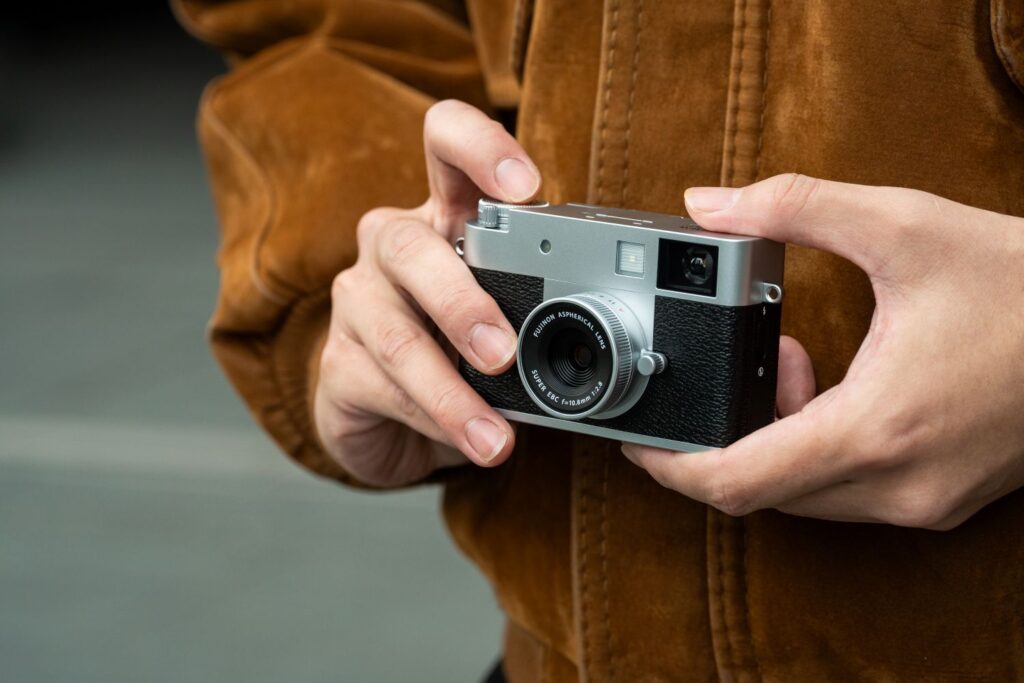The one thing I have in common with the average TikToker is my longing for expensive fixed-lens point-and-shoot cameras. It seems the two companies—Fujifilm and Ricoh—have the biggest brand recognition by the app-obsessed crowd, and they’re individually calling up two cameras to help feed audiences and algorithms alike. The first on our list from the folk at Fuji looks and feels incredibly old school, but it’s designed specifically to funnel vertically-oriented shots to an Instagram account.
We won’t have to wait long for the most anticipated cameras of the year. First up, Fujifilm finally announced its $850 X Half camera. If you’re wondering about the strange naming convention, it’s because the fixed-lens camera is a “half-frame” shooter with a portrait-oriented, 18-megapixel sensor. The lens is equivalent to 32mm with an f/2.8 aperture. It includes a far more shrimpy body and half the sensor size compared to the company’s landmark X100V and X100VI point-and-shooters. It sports an old-school, lightweight body complete with an actual working tactile frame advance lever. The rear screen is dedicated to seeing your shots in the 3:2 aspect ratio and for picking from 13 different film simulations that have become such a staple on Fuji’s digital products.
If you didn’t already think this camera was made for the person who simply wants to funnel their photos to Instagram, then know the Fujifilm X Half won’t shoot in RAW format, which is what the vast majority of professionals prefer for photo editing. Instead, it features a dedicated smartphone app. It will also operate with various Instax printers. Fujifilm said this camera is directed at the Gen Z audience who want a digital camera to use alongside their phone.
You need to use the frame advance lever after taking every image, which makes the X Half seem more of an expensive film camera simulation than a professional device. And yet, there’s something magical about the limitation inherent with film cameras that’s missing from today’s high-end digital devices. The camera even includes grain effect and time stamp options to add noise to your final shots. The Fujifilm X Half should be available in late June.

If you were looking for something that’s a little more typical, Ricoh is edging closer to finally unveiling the sequel to its all-time classic fixed-lens camera, the Ricoh GR III. In a release, Ricoh said the Ricoh GR IV is in development. It will sport a redesigned lens, a new sensor, and a redesigned digital imaging engine. The company suggested the new shooter may also connect to a new app, which should make it easier to get from the camera directly to your phone. We won’t actually get to see what it looks like until May 31, when it will be shown off at various GR Spaces in Tokyo, Beijing, and Shanghai. We’ll have to wait until the fall for a full release.
TikTok’s attention has largely spun away from its previous darling, the Fujifilm X100VI. That’s despite the initial glowing reviews of the more expensive $1,600 camera. The X100VI has been notoriously hard to acquire new or used. Meanwhile, the Ricoh GR III (which you can still find for under $1,000 used or about $1,100 new) has been around for more than five years, and it’s still one of the gold standards of this compact form factor thanks to its low-key design and its capacity to take crisp shots. There are two versions of that camera with the same 24.2-megapixel APS-C sensor—the GR III with the 28mm lens and the GR IIIX with a 40mm lens that’s better for close-ups and street photography.
It may be harder for today’s internet-famous photographers to get one of these cameras going forward. Ricoh said it will stop shipments of the GR III in July “due to difficulty in procuring parts and components,” but the GR IIIX should be available for a while longer. The wait until then may be excruciating for those of us desperate for another unassuming but ultimately powerful camera.

